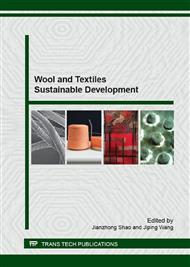[1]
Metz, B., et al., Carbon Dioxide Capture and Storage: Summary for policymakers and technical summary. IPCC-Special Report, ISBN, 2005: pp.92-9169.
Google Scholar
[2]
Aaron, D., et al., Separation of CO2 from flue gas: a review. Separation Science and Technology, 2005. 40(1-3): pp.321-348.
DOI: 10.1081/ss-200042244
Google Scholar
[3]
Abu-Zahra, M.R. M, et al., CO2 capture from power plants: Part II. A parametric study of the economical performance based on mono-ethanolamine. International Journal of Greenhouse Gas Control, 2007. 1(2): pp.135-142.
DOI: 10.1016/s1750-5836(07)00032-1
Google Scholar
[4]
Vevelstad, S.J., et al, Degradation of MEA; a theoretical study. Energy Procedia, 2011. 4: pp.1608-1615.
Google Scholar
[5]
Li, J.L., et al., Review of CO2 absorption using chemical solvents in hollow fiber membrane contactors. Separation and Purification Technology, 2005. 41(2): pp.109-122.
DOI: 10.1016/j.seppur.2004.09.008
Google Scholar
[6]
Yan, S., et al., Regeneration of CO2 from CO2-rich alkanolamines solution by using reduced thickness and vacuum technology: regeneration feasibility and characteristic of thin-layer solvent. Chemical Engineering and Processing: Process Intensification, 2009. 48(1): pp.515-523.
DOI: 10.1016/j.cep.2008.06.009
Google Scholar
[7]
Versteeg, G.F., et al., On the kinetics between CO2 and alkanolamines both in aqueous and non-aqueous solutions-I. Primary and secondary amines. Chemical Engineering Science, 1988. 43(3): pp.573-585.
DOI: 10.1016/0009-2509(88)87017-9
Google Scholar
[8]
Teramoto, M., et al., Separation and concentration of CO2 by capillary-type facilitated transport membrane module with permeation of carrier solution. Journal of Membrane Science, 2004. 234(1): pp.83-94.
DOI: 10.1016/j.memsci.2003.12.023
Google Scholar
[9]
Aboudheir, A., et al., Kinetics of the reactive absorption of carbon dioxide in high CO2-loaded, concentrated aqueous monoethanolamine solutions. Chemical Engineering Science, 2003. 58(23): pp.5195-5210.
DOI: 10.1016/j.ces.2003.08.014
Google Scholar
[10]
Abu-Zahra, M.R. M, et al., CO2 capture from power plants: Part I. A parametric study of the technical performance based on monoethanolamine. International Journal of Greenhouse Gas Control, 2007. 1(1): pp.37-46.
DOI: 10.1016/s1750-5836(06)00007-7
Google Scholar


